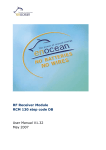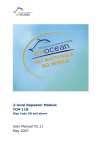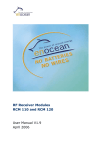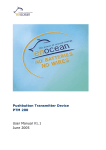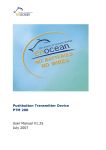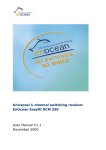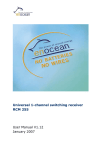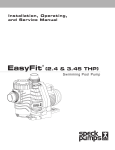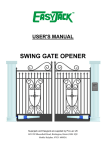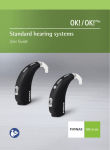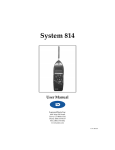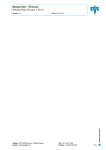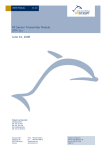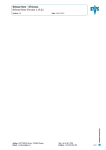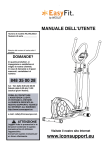Download Users Manual RCM 110/120
Transcript
RF Receiver Modules RCM 152 User Manual V1.31 October 2006 Revision History The following major modifications and improvements have been made to the initial version of the document (RCM 152 User Manual V1.0): Version Subject (major changes since last version) 1.1 Misprint correction: No preinstalled whip antenna (chapter 1.4) Output state after power up and learning phase described (chapter 2.3.2) Declaration of CE conformity enclosed (chapter 5) - 1.2 1.3 1.31 Supply voltage range and current consumption corrected Application note for power supply modified Published by EnOcean GmbH, Kolpingring 18a, 82041 Oberhaching, Germany www.enocean.com, info@enocean.com, phone ++49 (89) 6734 6890 © EnOcean GmbH, All Rights Reserved Important! This information describes the type of component and shall not be considered as assured characteristics. No responsibility is assumed for possible omissions or inaccuracies. Circuitry and specifications are subject to change without notice. For the latest product specifications, refer to the EnOcean website: http://www.enocean.com. As far as patents or other rights of third parties are concerned, liability is only assumed for modules, not for the described applications, processes and circuits. EnOcean does not assume responsibility for use of modules described and limits its liability to the replacement of modules determined to be defective due to workmanship. Devices or systems containing RF components must meet the essential requirements of the local legal authorities. The approval requirements described in this document are of best knowledge without any warranty. The modules must not be used in any relation with equipment that supports, directly or indirectly, human health or life or with applications that can result in danger for people, animals or real value. Components of the modules are considered and should be disposed of as hazardous waste. Local government regulations are to be observed. Packing: Please use the recycling operators known to you. By agreement we will take packing material back if it is sorted. You must bear the costs of transport. For packing material that is returned to us unsorted or that we are not obliged to accept, we shall have to invoice you for any costs incurred. ©EnOcean GmbH Page 2 of 20 RCM 152 User Manual V1.31 Table of Contents 1. GENERAL DESCRIPTION________________________________________________________________ 4 1.1 Basic Functionalities ________________________________________________________________ 4 1.2 Typical Applications _________________________________________________________________ 4 1.3 Features Overview __________________________________________________________________ 5 1.4 Physical Dimensions ________________________________________________________________ 5 1.5 Environmental Conditions __________________________________________________________ 6 1.6 Ordering Information _______________________________________________________________ 6 2. FUNCTIONAL DESCRIPTION ___________________________________________________________ 7 2.1 Block Diagram _______________________________________________________________________ 7 2.2 Pin Description ______________________________________________________________________ 7 2.3 Operating Modes ___________________________________________________________________ 10 2.4 Learning Modes ____________________________________________________________________ 11 2.5 Learning of Radio Transmitters ___________________________________________________ 11 2.6 Deleting Radio Transmitters_______________________________________________________ 12 2.7 Received Signal Strength Indicator (RSSI) _______________________________________ 13 3. APPLICATIONS INFORMATION _______________________________________________________ 14 3.1 Module Mounting ___________________________________________________________________ 14 3.2 Antenna Mounting__________________________________________________________________ 14 3.3 Transmission Range _______________________________________________________________ 16 3.4 Power Supply Requirements ______________________________________________________ 17 3.5 LMI Output Connection ____________________________________________________________ 17 3.6 CE Approval Requirements ________________________________________________________ 17 3.7 FCC/IC Approval Requirements ___________________________________________________ 18 4. DEVELOPMENT TOOLS _________________________________________________________________ 19 4.1 Evaluation Kit EVA 100 ____________________________________________________________ 19 4.2 Field Intensity Meter EPM 100 ____________________________________________________ 19 5. DECLARATION OF CE CONFORMITY __________________________________________________ 20 ©EnOcean GmbH Page 3 of 20 RCM 152 User Manual V1.31 1. GENERAL DESCRIPTION The receiver module RCM 152 is used to receive and to process telegrams generated and transmitted by EnOcean radio transmitters. These modules can be easily integrated into control and switching units for the implementation of different application-specific system solutions. 1.1 Basic Functionalities For the implementation of different application-specific system solutions the RCM radio modules can be easily integrated into control and switching units by using the functional control outputs (“open collector”). The RCM 152 is a firmware variant of the RCM 1xx receiver family of EnOcean. The hardware is fully compatible. Each RCM 152 receiver can be assigned, either a maximum of 30 EnOcean PTM radio switches, or up to 2 EnOcean easyfit STM 250 radio window contacts. Learning of mixed PTM and STM transmitters is not possible. By assigning the first transmitter the operating mode is defined. The operating mode can only be changed at empty ID memory, e.g. after deleting all transmitters with the CLR button. Mode RADIO SWITCH: Each assigned transmitter can be used to change the switching state of the receiver. It is possible to switch ON with one switch and OFF with another switch. Mode RADIO WINDOW CONTACT: If at least one of the assigned window contacts is open the switching state of the receiver is ON. If both contacts are closed the state is OFF. The radio window contacts are transmitting a life signal typically every 15 min. Around 60 min after reception of the last life signal the receiver considers this contact to be closed. Figure 1: Receiver module RCM 152 1.2 Typical Applications • Building installation • Industrial automation • Consumer electronics ©EnOcean GmbH Page 4 of 20 RCM 152 User Manual V1.31 The RCM modules are part of a powerful RF system solution from EnOcean for operation and control applications. Because the RF transmitters are self-powered (no batteries), maintenance-free RF systems can be implemented. The RCM modules operate together with the following further EnOcean components: PTM (batteryless radio switches), STM (batteryless radio sensors) and TCM (bi-directional radio modules) 1.3 Features Overview Power Supply: ........................................................................................ 5 V DC ± 5 % Current Input: ............................................................ 29 mA max. (without output load) Receive Frequency: ................................................ 868.3 MHz (stabilized by crystal PLL) Sensitivity / Channel Bandwidth: ..................................................... -95 dBm / 280 kHz Control Inputs: ................................... 6 inputs for set up of operating and learning modes Functional Outputs: ......... 4 outputs, their function depends on the selected operation mode Learning Mode Output: ................................................ indicates learning of transmitters Number of RF transmitters learnable: ............................. up to 30 EnOcean transmitters Note: In serial mode all received EnOcean telegrams are transmitted RSSI Output:.........................................................indicates received peak signal strength Direct Signal Output: .................................................. physical layer 1 output (120 kbps) 1.4 Physical Dimensions Antenna:.................................. 9 cm whip antenna or external 50 Ohm antenna mountable Dimensions of PCB: ........................................18.0 x 42.0 x 5.5 mm (without wiring pins) Connector: ........................................16 pins, grid 2.0 mm (4.0 mm in length, ©EnOcean GmbH Page 5 of 20 0.5 mm) RCM 152 User Manual V1.31 2 0.5 4 Pin 1 18 Pin 16 Antenna 42 Pin 1 5.5 2.45 Pin 16 30 1.225 Figure 2: RCM 110 and RCM 120 package outlines 1.5 Environmental Conditions Operating Temperature:..................................................................... -25 up to +65 °C Storage Temperature: ........................... -40 up to +85 °C, +85 up to +100 °C for 1h max. Humidity:............................................................................................ 0 % to 95 % r.h. 1.6 Ordering Information Type EnOcean Ordering Code RCM 152 S3002-B152 ©EnOcean GmbH Remarks Page 6 of 20 RCM 152 User Manual V1.31 2. FUNCTIONAL DESCRIPTION 2.1 Block Diagram 14 RSSI RXD 13 Ant 8 OUT_0 OUT_1 OUT_2 OUT_3 9 CODE_0 CODE_1 CODE_2 2 3 Mode 4 15 10 µC 11 12 1, 16 5 LRN VCC GND 6 SSLM LMI 7 CLR Figure 3: Block diagram of RCM 110 and RCM 120 2.2 Pin Description Pin No. Symbol Function 1 GND_0 Ground connection 2 3 4 CODE_0 CODE_1 CODE_2 ©EnOcean GmbH Operational characteristics Encoding input for operation mode selection (configuration of the receiver firmware). The operation mode is defined at the first power-up in accordance to the pin connecting. A later change of the operation mode is possible at power-up, but only if the ID memory is cleared in addition (connect CLR-pin to GND -> power-down -> change CODE-pin connecting -> power-up). Page 7 of 20 Resistor network input. Code pins should be left open or connected to GND (for encoding schematics, see chapter 2.3) RCM 152 User Manual V1.31 5 LRN Control input to enter and to stop transmitter learning mode: see 2.5 Learning of Radio Transmitters. During transmitter learning mode, the sensitivity of the receiver is reduced to in-room operation. Resistor network input: Connect the open LRN pin to GND for longer than 0.5 sec. 6 SSLM n.a. Resistor network input: Must be left open! 7 CLR Control input to clear the receiver ID and scene memory (all learned switch rockers, sensors and scene switches) Resistor network input: Connect the open CLR pin to GND for longer than 2 seconds. 8 9 10 11 OUT_0 OUT_1 OUT_2 OUT_3 Functional control outputs (see chapter 2.3). Also indicate current learning mode status (see 2.5 Learning of Radio Transmitters). Open collector outputs. 35 V max., 100 mA max., 100 mW max. each. 12 LMI Learning Mode indication output: LMI is Active High in the learning mode phase. For optical indication, LEDs can be connected with one lead directly to the functional control outputs. The other lead of the LEDs can be connected to the LMI pin in common, so Learning Mode LEDs are switched off in operation mode. If desired, the LMI pin can also be used to switch off loads within learning mode (in addition see Application Note chapter 3.5). 5 V TTL output, 20 mA max. 13 RXD Digital direct output of all received radio bit streams (physical layer 1, 120 kbps). Note: Not defined for a further data processing by the user! RCM 120 in Operating Mode 0 offers at OUT_0 a 9.6 kbps standardized serial data output. 5 V TTL output, source impedance 11 KΩ 14 RSSI Indication output of received signal strength (peak detection) Source impedance app. 20 KΩ 15 VCC Power supply 5 V DC ± 5%, 29 mA max. (without LMI output current) 16 GND_1 ©EnOcean GmbH Ground connection Page 8 of 20 RCM 152 User Manual V1.31 VCC VCC 10K 10K CODE_2 8K2 CODE_1 10K CODE_0 22K ADC (internal (Mode) CLR 8K2 SSLM 10K LRN 22K 100n ADC (internal) (Mode) 100n Figure 4: Equivalent schematics of Control Inputs (pins 2 to 7) OUT_x external OC (external (Open ) Collector) 4K7 OUT_x internal TTL (TTL) ) (internal 22K Figure 5: Equivalent schematics of Functional Outputs (pins 8 to 11) ©EnOcean GmbH Page 9 of 20 RCM 152 User Manual V1.31 2.3 Operating Modes 2.3.1 Hardware enabled Operating Modes The following operating modes can be configured by the encoding inputs CODE_2..0. The operating mode is defined with pin status at power-up; a change of operation mode is possible with cleared ID memory only. Mode Function Output signal description No. of channels CODE _2 CODE _1 CODE _0 0 None NC NC NC 1 None NC NC GND 2 Simple switch actor NC GND NC 3 None NC GND GND 4 None GND NC NC 5 None GND NC GND 6 None GND GND NC 7 Test GND GND GND Supplies the desired logic switching state “on/off” at OUT_0 (1 channel) Reserved (factory test mode) 1 (OUT_0) 2.3.2 Firmware enabled Operating Modes Each RCM 152 receiver can be assigned, either a maximum of 30 EnOcean PTM radio switches, or up to 2 EnOcean easyfit STM 250 radio window contacts. Learning of mixed PTM and STM transmitters is not possible. By assigning the first transmitter the Firmware Operating Mode is defined. The Firmware Operating Mode can only be changed at empty ID memory, e.g. after deleting all transmitters with the CLR button. a) Mode RADIO SWITCH: Each assigned transmitter can be used to change the switching state of the receiver. It is possible to switch ON (button I) with one switch and OFF (button O) with another switch. Initialization: After Power-up and Learning Phase the module output OUT_0 is inactive (“off”). At least one of the learned radio switches have to be operated to switch the output. b) Mode RADIO WINDOW CONTACT: If at least one of the assigned window contacts is open the switching state of the receiver is ON. If both contacts are closed the state is OFF. Time Out: The radio window contacts are transmitting a life signal typically every 15 min (5…30 min). 60 min (± 10%) after reception of the last life signal the receiver considers this contact to be closed. Initialization: After Power-up and Learning Phase the module output OUT_0 is inactive (“off”). At least one of the learned magnet contacts have to be opened to release the output immediately (before first incoming presence signal). ©EnOcean GmbH Page 10 of 20 RCM 152 User Manual V1.31 2.4 Learning Modes The following learning modes are implemented within the RCM 152 module: 1.) Learning Mode CLR: ID Memory Reset. All learned transmitter IDs are deleted. Learning mode LRN is entered subsequently. CLR mode has to be entered also for changing the receiver operating mode (changed connections pattern at pins CODE_2..0 is taken over). 2.) Learning Mode LRN: Transmitter Learning Mode entered via LRN pin: The receiver sensitivity is limited to in-room operation, learning of repeater-powered signals is disabled. The telegram of the associated radio transmitter has to be triggered one time at least (pressing the desired switch rocker or triggering a sensor). 3.) Learning Mode RLM: Not available with RCM 152. 4.) Learning Mode SSLM: Not available with RCM 152. Indistinct signal or pin configurations are ignored at all times. Within the learning procedure, the learning mode cannot be changed. 2.5 Learning of Radio Transmitters Please also draw attention to the notes about learnable transmitters in chapter 2.2 “Operating Modes”. LMI pin is active high during all learning modes. 1.) Setting the receiver to learning mode - Via CLR Pin: Contact to GND longer than t = 2 sec. Learning Mode LRN is entered after clearing transmitter-ID memory. - Via LRN Pin: Contact to GND longer than t = 0.5 sec. In multi-channel receiver modes, the pin has to be contacted several times until the desired channel number is selected (the number of channels is given by the selected operating mode = Code_2..0 pin configuration). - Via Configuration Remote Control: Not possible with RCM 152. - Via SSLM Pin: Not available with RCM 152. 2.) The receiver will confirm Learning Mode (i.e. via LEDs in parallel to the output pins) Output of the selected channel is flashing (1 sec. active / 1 sec. inactive) 3.) Ensure that the associated radio transmitter will be in a distance less than 5 m to the receiver In learning mode, the sensitivity of the RCM module is limited to in-room operations and learning of repeater powered signals is disabled (to avoid unintentional learning). ©EnOcean GmbH Page 11 of 20 RCM 152 User Manual V1.31 5.) Trigger the telegram of the associated radio transmitter within 30 sec. at the latest - Operate the PTM switch radio transmitter at least once (press I-button or O-button of the rocker that is to be assigned to the selected receiver channel). - Or press the LEARN button of the STM 250 magnet contact transmitter at least once. - Through fresh contacting of the LRN pin to GND, Operation Mode is entered again (no output is flashing any more and LMI output changes to inactive). - After approx. 30 seconds of inactivity (no transmitter has been triggered), the receiver switches back from Learning Mode to Operating Mode automatically. 6.) The receiver will confirm the correct learning of transmitter ID code The output of the selected channel remains in active state for 4 sec. 7.) Learning of further transmitters After confirmation, the receiver changes again to readiness for learning. Further transmitters can be learned immediately. A maximum of 30 PTM transmitters or 2 STM 250 transmitters can be learned (further attempts will be ignored; instead of learning confirmation, Operation Mode is entered). 8.) Leave the learning mode Contact again the LRN pin to GND longer than t = 0.5 sec. Note: After passing the Learning Mode the OUT_0 open collector output is inactive and, if STM 250 are learned, the Time Out Timer is reset. 2.6 Deleting Radio Transmitters a) Deletion of one specific transmitter: Use the same procedure as learning the associated transmitter As transmitter delete confirmation, the corresponding function outputs remain in inactive state for 4 sec. while LMI keeps active. After that, a wrongly deleted transmitter can be learned again immediately. b) Deletion of all learned transmitters: Connect the CLR pin longer than 2 sec. to GND All learned transmitters on all channels are deleted at the same time. After this, the receiver enters Learning Mode LRN. ©EnOcean GmbH Page 12 of 20 RCM 152 User Manual V1.31 2.7 Received Signal Strength Indicator (RSSI) The RSSI output of the RCM module is useful for transmission range tests. By indicating the strength of an incoming RF signal, this output allows the assessment of RF link quality and transmission range. The RSSI pin output voltage is typically 0.9 V with no RF signal, rising to typically 2.6 V at maximum signal. The external loading should be kept to a minimum since the RSSI output source impedance is around 20 kOhm. The following shows a typical RSSI characteristic: RSSI output (mV) 3000 2500 2000 1500 1000 500 -120 -110 -100 -90 -80 -70 -60 -50 -40 -30 -20 -10 0 RF input (dBm) Figure 11: RSSI output characteristics ©EnOcean GmbH Page 13 of 20 RCM 152 User Manual V1.31 3. APPLICATIONS INFORMATION 3.1 Module Mounting The modules may be mounted in vertical or horizontal position to the user board of the application device (load module). In a vertical position, the module pins can be directly connected to the user board through suitable PCB holes. Optionally suitable female strip connectors can be used, available e.g. from Conrad Electronic GmbH (Ordering No. 73 92 43). Additional module fixing may be necessary in rough environments. The following features have to be available on the motherboard: - Load circuit, i.e. power switches or serial interface driver (connected to RCM functional output pins OUT_0..3) - Power supply for the receiver module (GND_0, GND_1, VCC) and for the load circuit - Configuration of the receiver firmware (connecting of input pins CODE_0, CODE_1 and CODE_2) - Programming pushbuttons for channel storing (connecting of input pins LRN and CLR) - If needed, Learn Mode indication circuitry: LED(s) for providing optical feedback and/or a load output decoupling logic - External connectors 3.2 Antenna Mounting Positioning and choice of receiver and transmitter antennas are the most important factors in determining system transmission range. The RCM 152 receiver modules are supplied without antenna as a standard. For mounting the antenna, the following notes should be considered to optimize the system performance: a) Mounting a 1/4-wave whip antenna: A whip antenna enables a very compact receiver unit with good radio reception characteristics. For good receiver performance, great care must be taken about the space immediately around the antenna since this has a strong influence on screening and detuning the antenna. The antenna should be drawn out as far as possible and must never be cut off. Mainly the far end of the wire should be mounted as far away as possible from all metal parts, PCB strip lines and fast logic components (e.g. microprocessors). To avoid radio frequency noise from the motherboard, which desensitizes the receiver, PCB strip lines on the user board should be designed as short as possible, and using PCB ground plane layer is also recommended. Note that 868 MHz whip antennas do not show any directional effects under free-field radiowave propagation conditions (spot-wise radiator). The RSSI voltage output can be used for evaluating the influence of intuitive RF optimizations. For a good antenna performance don’t roll up or twist the whip and please draw attention to an overall whip distance of at least 10 mm (20 mm is better) from any PCB strip, ground plane and conductive part or electric part. ©EnOcean GmbH Page 14 of 20 RCM 152 User Manual V1.31 Figure 13: Specification of the RCM whip antenna b) Mounting an external antenna: For mounting the receiver at bad RF locations (e.g. within a metal cabinet), an external antenna has to be used. After resoldering the pre-installed whip antenna, the external antenna can be connected to the equipment by a 50-Ohm coax feeder with Teflon insulation as follows (connect the inner cable to the resoldered hole, and solder the shielding as short as possible to the RCM Groundplane, length of insulation max. 4 mm): Figure 14: Mounting an external antenna ©EnOcean GmbH Page 15 of 20 RCM 152 User Manual V1.31 3.3 Transmission Range The main factors that influence the system transmission range are type and location of the antennas of the receiver and the transmitter, type of terrain and degree of obstruction of the link path, sources of interference affecting the receiver, and “Dead” spots caused by signal reflections from nearby conductive objects. Since the expected transmission range strongly depends on this system conditions, range tests should categorically be performed before notification of a particular range that will be attainable by a certain application. notification of a particular range that will be attainable by a particular application. The following figures for expected transmission range are considered by using a PTM, a STM or a TCM radio transmitter device and the RCM or the TCM radio receiver device with preinstalled whip antenna and may be used as a rough guide only: • • • • • Line-of-sight connections: Typically 30m range in corridors, up to 100m in halls Plasterboard walls / dry wood: Typically 30m range, through max. 5 walls Brick walls / aerated concrete: Typically 20m range, through max. 3 walls Ferroconcrete walls / ceilings: Typically 10m range, through max. 1 ceiling Fire-safety walls, elevator shafts, staircases and supply areas should be considered as screening. The angle at which the transmitted signal hits the wall is very important. The effective wall thickness – and with it the signal attenuation – varies according to this angle. Signals should be transmitted as directly as possible through the wall. Wall niches should be avoided. Other factors restricting transmission range: • • • • Switch mounted on metal surfaces (up to 30% loss of transmission range) Hollow lightweight walls filled with insulating wool on metal foil False ceilings with panels of metal or carbon fiber Lead glass or glass with metal coating, steel furniture The distance between EnOcean receivers and other transmitting devices such as computers, audio and video equipment that also emit high-frequency signals should be at least 0.5m A summarized application note to determine the transmission range within buildings are available as download from www.enocean.com. Attention for US applications: Please note that 868 MHz is used in the United States of America by trunk radio also. A decrease of transmitter range should be considered, mainly near to radio beacons of fire brigades. ©EnOcean GmbH Page 16 of 20 RCM 152 User Manual V1.31 3.4 Power Supply Requirements In order to provide a good radio performance, a great attention must also be paid to the power supply and a correct layout and shielding, especially when this power supply also supplies possible sources of interference like oscillators or other digital circuits at the same time. Digital switching is very fast and creates high frequency interferences. A star-connected topology and at least a 10uF low-ESR tantalum or similar ceramic capacitor is recommended to be added as close as possible to module, between the module supply pin Vcc and GND, together with a low DC-resistance (<1 Ω) EMI-suppressor, like a ferrit bead e.g. multi layer suppressor type MLS0805-4S7-102 from Ferroxcube, series feed between the board supply pin input and the output of the power supply rail. The ripple on the 5V (±5%) power supply rail should be below 10mVp-p. 3.5 LMI Output Connection Example of a learning status indication by LEDs at 2 channels mode with decoupled loads during learning mode (the decoupling of the load is only necessary if status indication through connected actors is not appropriate). Note: LMI is Active High during learning mode; OUT_0 and OUT_1 are open collector outputs (Active Low). OUT_1 OUT_0 LMI Figure 15: Example of LMI output connection 3.6 CE Approval Requirements The modules bear the EC conformity marking CE and conforms to the R&TTE EU-directive on radio equipment. The assembly conforms to the European and national requirements of electromagnetic compatibility. The conformity has been proven and the according documentation has been deposited at EnOcean. The RCM modules can be operated without notification and free of charge in the area of the European Union, in Switzerland, in Cyprus, in Czech, in Estonia, in Hungary, in Latvia, in Lithuania, in Malta, in Poland, in Romania and in Slovenia. The following provisos apply: ©EnOcean GmbH Page 17 of 20 RCM 152 User Manual V1.31 • EnOcean RF modules must not be modified or used outside their specification limits. • EnOcean RF modules may only be used to transfer digital or digitized data. Analog speech and/or music are not permitted. • The final product incorporating EnOcean RF modules must itself meet the essential requirement of the R&TTE Directive and a CE marking must be affixed on the final product and on the sales packaging each. Operating instructions containing a Declaration of Conformity has to be attached. • If transmitters are used according to the regulations of the 868.3 MHz band, a so-called “Duty Cycle” of 1% per hour for each transmitter must not be exceeded. 3.7 FCC/IC Approval Requirements Because of the very low radiated field strength on average, the 868.3 MHz EnOcean radio technology can be approved in the USA and in Canada. In the US approval of receivers is not necessary in general. On a voluntary base an US representative can last out a "Declaration of Conformity" (DOC) together with technical documentation. The measurements has to be done by a FCC notified body with respect to FCC Part 15B. Product labeling should be according Part 15 of the FCC Rules, page 11. In Canada receivers < 960 MHz must be approved! The measurements of the finished device has to be done by a IC notified laboratory with respect to RSS-210 of Industry Canada, section 7. The receiver has to be labeled with IC approval number. Please note: 868 MHz frequency range is used by Trunk Radio in the US. Since a clear reduction of transmission range is to be expected near to trunk radio stations, range tests at the system’s target location should categorically be performed before notification of a particular range in the US and Canada! ©EnOcean GmbH Page 18 of 20 RCM 152 User Manual V1.31 4. DEVELOPMENT TOOLS 4.1 Evaluation Kit EVA 100 EVA 100 is an evaluation kit to support the development of applications based on the EnOcean receiver modules RCM 1xx. EVA 100 supports a quite easy setting-up operation of the receiver side when EnOcean transmitter modules are evaluated. Type EVA 100 EnOcean Ordering Code H3004-G100 Scope of supply • Evaluation board EVA-PCB • EnOcean radio transmitter devices PTM 100 and STM 100 • EnOcean receiver modules RCM 110 and RCM 120 • CD with RS232 PC-link monitor software and detailed kit documentation • Wall power supply for EVA-PCB • Convenient equipment case 4.2 Field Intensity Meter EPM 100 The EPM100 is a mobile field-intensity meter that helps the engineer to find the best installation positions for sensor and receiver. It can also be used to check disturbances in links to already installed equipment. The EPM100 displays the field intensity of received radio telegrams and interfering radio signals in the 868MHz range. The simplest procedure for determining the best installation positions for the radio sensor/receiver: • Person 1 operates the radio sensor and generates pushbutton radio telegrams. • Person 2 checks the received field intensity on the meter display to find the optimal installation position. ©EnOcean GmbH Page 19 of 20 RCM 152 User Manual V1.31 5. DECLARATION OF CE CONFORMITY ©EnOcean GmbH Page 20 of 20 RCM 152 User Manual V1.31




















